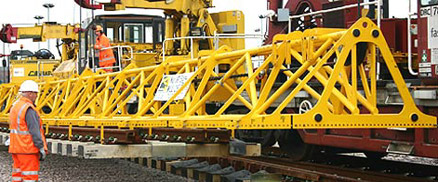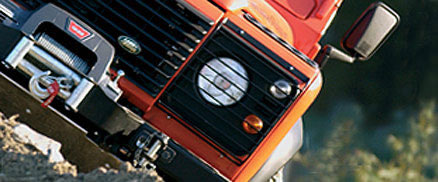May 23rd, 2010
Special precautions need to be taken when working trackside with live electric cables. If you are involved with repair or are responsible for maintaining cables special precautions must be taken at all times to ensure employee safety. Once the cable has been made dead and then connected to earth at the point of supply, the cable is then cut, usually by a hacksaw or cable cutters.
In order to enable the spiking operation to be carried out in perfect safety, a cable spiker tool needs to be used as it has the great advantage that it can be remotely controlled at the moment of firing by means of a lanyard (rope) release. The operator using the spiker can stand at a point of safety and if accidentally a “live” cable is spiked, the damage will only be local to the cable. As the speed of penetration of the spiking punch is so rapid, it has been found in practice that even if a “live” cable is spiked, usually no damage to the cable spiker results. If however, the fault current happens to be extremely high, it may be that the actual spiking punch itself may suffer, but yet be capable of tripping a normally operating breaker. An added feature of the cable spiker is that the wide punch shears the cable partially or totally, depending on the cable size, hence reducing additional cable cutting effort.
The cable spiker is suitable for use with all types and voltages of power cable including single and multiple conductor laminated, polymeric, elastomeric, unshielded, shielded, concentric neutral, interlock armoured, steel wire armoured, leaded covered etc. designs in either fixed or portable installations.
The cable spiker is a quality durable tool designed to positively electrically ground out any required power cable for definite manpower accident prevention and life saving to anybody working with live cables.
Posted in Arbil Rail |
May 23rd, 2010
Shackles are used in lifting and static systems as removable links to connect (steel) wire rope, chain and other fittings. Screw pin shackles are used mainly for non-permanent applications. Safety bolt shackles are used for long-term or permanent applications or where the load may slide on the pin causing rotation of the pin. Chain or dee shackles are mainly used on one-leg systems whereas anchor or bow shackles are mainly used on multi-leg systems.
Van Beest offers a wide range of bow and dee shackles, depending on the application on which the shackle is going to be used; the range stretches from Working Load Limit (WLL) 0.33 tons to 1500 tons. Van Beest offer an extensive range to choose the shackle exactly suitable for the application. Most of the shackles are directly available from stock. Furthermore, shackles can be supplied to many standards such as the US Federal Specification RR-C-271, EN 13889, British Standard 3032, DIN 82101, DIN 82016 etc.
Polar shackles are for use in extreme climatic conditions with material properties guaranteed up to temperatures of -40oC, and furthermore we offer a wide range of general commercial shackles, which are not suitable for lifting but merely for fixing purposes.
All Van Beest shackles have a specific design for a specific application. Examples are the “Super” shackles which are made out of grade 8 steel enabling the dimensions of the shackles to be minimized for use in limited space conditions, without loss of functionality or Working Load Limit. Or sling shackles for use with large slings, to provide a better radius to the sling being used. Another example of functional design is the use of shackles where the pin has a square sunken hole so as not to obstruct the use of fishing nets. These are all examples of a highly functional design, to optimize the use of the Van Beest shackles in daily use.
Shackles supplied by Van Beest can be either hot dipped galvanized, electro-galvanized, painted or self coloured, depending on the type of shackle and its application.
Posted in Arbil Lifting Gear |
May 23rd, 2010
If you take good care of your electric winch, it will last for many years of use. Follow the winch maintenance checklist below to keep your winch in good working condition.
Winch Cable (Synthetic or Wire)
- Check for kinks, fraying, and other damage before and after each winching operation.
- Replace the cable immediately if you see signs of damage. Do not use a damaged rope.
- Keep the rope clean and dry.
- Spool the cable neatly and evenly onto the drum after you are done winching.
Electrical and Hardware
- Check the electrical connections every few months to make sure they are clean and tight.
- Remove dirt and corrosion from the electrical connections. If you allow the corrosion to build up, it may reduce the performance of your winch or cause a short.
- Power the cable in or out every few months, whether you need to use the winch or not. Periodically running the motor will create heat and dissipate any moisture built up in the motor. If the winch is not operated for a long period of time, this moisture will lead to internal corrosion and damage the motor.
- If you live and ride in salty areas, coat the electrical connections with silicone to prevent corrosion.
- Periodically check all mounting bolts for tightness.
Cleaning and Greasing
- The gearbox and drum bearings are permanently lubricated. No internal lubrication should be required for the life of the winch.
- If you take apart the winch for repair or cleaning, however, it will be necessary to re-lubricate the winch.
Posted in Arbil 4x4 |
May 7th, 2010
Gravity can kill but you can defy it. Using a fall protection system can prevent any injuries or fatalities. Falls from heights are one of the leading causes of serious injury and death at the work place. Analysis of all industrial accidents usually highlights inappropriate working conditions as a principal factor. In the case of working at heights, the consequences are immediate and serious, resulting in major disability or death. Approximately one in seven work place fatalities are due to a fall from heights.
The TurboLite PFLs are extremely lightweight and compact as well as being self retracting providing an incredible 6-foot of working capacity. The built-in swivel of the units prevents the lifeline from twisting and binding inside the unit and permits movement in multiple directions for greater mobility. The high-strength impact-resistant nylon housing of the TurboLite units provides maximum durability and protection to the internal components.
The braking mechanism, power spring and shaft are all constructed of high-quality corrosion resistant stainless steel. The lanyard webbing has a 1-inch wide Veteran core and polyester outer jacket that is specially engineered for maximum abrasion resistance and durability. No annual factory recertification is required. The capacity rating of the Twin Turbo system is 400 lbs., total weight of worker and tools.
This fall Protection Systems:
- Eliminates the need for different fall protection equipment to address changes in fall clearance
- Reduces risk because workers at height are using proper equipment when fall clearance changes
- Increases productivity by keeping workers on the job longer
- Keeps safety costs in line as it is competitively priced with shock-absorbing lanyards
This Fall Protection System is ideal for people working at height as it is small and lightweight. If a fall should occur whilst using this fall Protection System then the worker will be suspended a short distance below the area they were working making rescue easier and safer for both the worker that has fallen and the rescuer. Using this particular Fall Protection system eliminates any possibility of tripping hazards that are usually associated with lanyards.
The Twin Turbo Fall Protection system is widely used and has greatly reduced the risk of sustaining injury whilst working overhead.
Posted in Arbil Rail |
May 7th, 2010
Polyester roundslings are widely used in industry. They are:
- very lightweight and flexible
- gentle to the load they are carrying
- high strength
- have a long life
All roundslings are manufactured to EN1492-2:2000 standard and are constructed from high tenacity polyester yarn. Roundslings are very easy to use. All roundslings are colour coded to give easy identification on the safe working load. They come labelled, giving length and safe working load. The inner core of the roundsling is made from high tensile polyester fibre which is wound continuously without a join to provide maximum possible strength. The core of the sling is protected by a tough woven tubular sleeve also made from polyester without a side stitch. This serves to protect both the inner core of the sling and the surface of the product when lifting. The low stretch characteristics of the polyester yarn also prevents ‘load bounce’ when lifting heavy loads. One advantage of round slings is that they are unaffected by sunlight, humidity and grease and can be used in a multitude of lifting applications.
Consideration should be given to the required working load limit when using roundslings. The shape, size and weight of the load, together with the intended method of use, working environment and nature of the load are all important factors. The slinging lifting and lowering operation should be planned before commencing the lift. The selected sling should be both strong enough and of the correct length for the mode of use.
When using roundslings the following should always be adhered to:
- Slings should never be dragged from under loads.
- Never knot or twist a sling.
- All slings should be inspected before use by a competent person.
- Use only slings with a reference number traceable to a test certificate.
- All steel fittings connected to the sling should be smooth and free of sharp edges and of such dimensions as not to tear or overload the eye.
- Never attempt to repair slings, if in doubt withdraw from service and consult the supplier or manufacturer.
- Avoid snatch or shock loading.
- Avoid contact with heat and hot surfaces.
- Never trap a roundsling under a load as crushing can seriously damage a sling
Posted in Arbil Lifting Gear |


